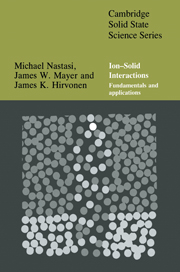Book contents
- Frontmatter
- Contents
- List of symbols
- Preface
- Chapter 1 General features and fundamental concepts
- Chapter 2 Interatomic potentials
- Chapter 3 Dynamics of binary elastic collisions
- Chapter 4 Cross-section
- Chapter 5 Ion stopping
- Chapter 6 Ion range and range distribution
- Chapter 7 Radiation damage and spikes
- Chapter 8 Ion–solid simulations and diffusion
- Chapter 9 Sputtering
- Chapter 10 Order–disorder and ion implantation metallurgy
- Chapter 11 Ion beam mixing
- Chapter 12 Phase transformations
- Chapter 13 Ion beam assisted deposition
- Chapter 14 Applications of ion beam processing techniques
- Chapter 15 Ion beam system features
- Appendix A Crystallography
- Appendix B Table of the elements
- Appendix C Density of states
- Appendix D Derivation of the Thomas–Fermi differential equation
- Appendix E Center-of-mass and laboratory scattering angles
- Appendix F Miedema's semi-empirical model for the enthalpy of formation in the liquid and solid states
- Appendix G Implantation metallurgy – study of equilibrium alloys
- Appendix H Physical constants, conversions and useful combinations
- Index
Chapter 14 - Applications of ion beam processing techniques
Published online by Cambridge University Press: 27 January 2010
- Frontmatter
- Contents
- List of symbols
- Preface
- Chapter 1 General features and fundamental concepts
- Chapter 2 Interatomic potentials
- Chapter 3 Dynamics of binary elastic collisions
- Chapter 4 Cross-section
- Chapter 5 Ion stopping
- Chapter 6 Ion range and range distribution
- Chapter 7 Radiation damage and spikes
- Chapter 8 Ion–solid simulations and diffusion
- Chapter 9 Sputtering
- Chapter 10 Order–disorder and ion implantation metallurgy
- Chapter 11 Ion beam mixing
- Chapter 12 Phase transformations
- Chapter 13 Ion beam assisted deposition
- Chapter 14 Applications of ion beam processing techniques
- Chapter 15 Ion beam system features
- Appendix A Crystallography
- Appendix B Table of the elements
- Appendix C Density of states
- Appendix D Derivation of the Thomas–Fermi differential equation
- Appendix E Center-of-mass and laboratory scattering angles
- Appendix F Miedema's semi-empirical model for the enthalpy of formation in the liquid and solid states
- Appendix G Implantation metallurgy – study of equilibrium alloys
- Appendix H Physical constants, conversions and useful combinations
- Index
Summary
Introduction
Ion implantation has been investigated with the intention of beneficially modifying surface sensitive properties since the early 1970s. A large share of the early work in this field was performed at Harwell, the UK Atomic Energy Establishment, with an emphasis on (i) tribological properties as modified by nitrogen implantation and (ii) oxidation resistance. Subsequently, several other laboratories worldwide became engaged in ion implantation research, and the range of topics explored expanded to cover other topics and substrates (i.e., ceramics and polymers). Interests started turning to the hybrid technique combining concurrent ion bombardment and physical vapor deposition in the early 1980s, and it continues to the present (1995).
Ion implantation – advantages and limitations of the technique
Ion implantation for the controlled modification of surface sensitive properties has had two principal thrusts: (i) as a metallurgical tool for studying basic mechanisms in areas such as aqueous corrosion, high-temperature oxidation, and metallurgical phenomena (e.g., impurity trapping); and (ii) as a means of beneficially modifying the mechanical or chemical properties of materials. This chapter includes examples of both usages, and will review the present status of some of the most active research fields outside of the semiconductor area. Table 14.1 shows a compilation of material properties influenced by ion implantation.
Some of the advantages and limitations of ion implantation in comparison with other surface treatments, such as coatings, are listed in Table 14.2.
- Type
- Chapter
- Information
- Ion-Solid InteractionsFundamentals and Applications, pp. 408 - 454Publisher: Cambridge University PressPrint publication year: 1996



